|
Prone Guns for 300m and Beyond
Two Top Shooters Share Their Tips on Prone Shooting Techniques
Other Guns of the Week >
This week, two skilled prone shooters team up to explore the world of prone precision shooting, focusing on "sling and irons" marksmanship. German Salazar, who runs ShootersJournal.com, is a very successful competitive shooter, holding "Distinguished" status in three disciplines: Highpower Rifle, Smallbore Prone, and Pistol. German was the 2004 300 Meter Open Class National Champion, the 2004 Florida 600-yard Prone State Champion, and the 2005 Arizona Smallbore Prone State Champion. Californian Scott Parker is also a skilled prone shooter with many wins in West Coast regional matches. Scott's ultra-accurate
Mastin/Barnard 6BRX was recently featured on this website, and this editor can personally attest to Scott's wizardry with irons and sling. Together, Scott and German explore the fine points of prone shooting through a Socratic-style dialog that will interest all prone shooters, from 50m rimfire enthusiasts, to long-range
full bore and Palma competitors.
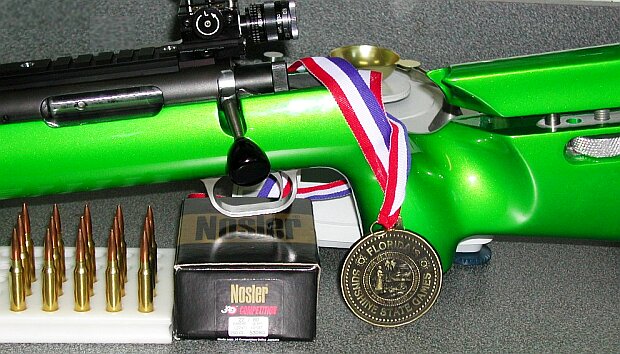
German Salazar's MasterClass prone stock with Quadlite action, Warner sights.Now a 22 PPC, it is shown with .223 Rem barrel.
| Prone Shooting--Elements of Successful Marksmanship |
General Prone Position--American-Style vs. Euro-style
Parker: German, most members of the U.S. Palma Team use a long, low position with the hand stop far forward and the body mostly inline with the rifle. This position is not as widespread among European shooters. So which method is best? What does your position look like and feel like?
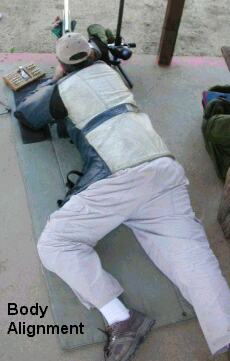 Salazar: Scott, positions are talked about a great deal--perhaps more than they merit. But nonetheless they deserve our attention as a good position is truly the foundation of successful prone shooting. Building a position is a circular exercise because it depends on proper rifle adjustments but those adjustments, in turn, depend on the position. I suspect most of us sneak up on the ideal position over a long period of experimentation and adjustment. Salazar: Scott, positions are talked about a great deal--perhaps more than they merit. But nonetheless they deserve our attention as a good position is truly the foundation of successful prone shooting. Building a position is a circular exercise because it depends on proper rifle adjustments but those adjustments, in turn, depend on the position. I suspect most of us sneak up on the ideal position over a long period of experimentation and adjustment.
My position has evolved over many years of prone shooting (since 1971) and is fairly low. In fact, upon the imposition of a 30° arm rule in Smallbore, I had to make an adjustment in my position to be sure I complied. I prefer not to compare my position to that of other shooters in a hypothetical sense, but there are some specific points I look for.
1. Stability: Let’s face it, if the position isn’t stable, then it isn’t worth pursuing. Prone is an inherently stable position because of the large amount of body contact with the ground as well as the low center of gravity. However, with a bit of attention to detail, a shooter can build a “more stable” prone position. A useful test of stability is to remove the trigger hand from the rifle while on aim--the rifle should not move at all. I do this as a natural point of aim check on each shot.
2. Durability: Once a string of fire starts, it's going to take an act of Congress to get me to remove the rifle from my shoulder. The simple reason is that I want to fire my 22 shots from one position, not 22 positions. Therefore, the position has to be durable. Proper butt-plate and sling adjustments will keep the rifle firmly in the shoulder (without pain or discomfort) and proper comb height adjustments will keep your neck from straining. Ideally, your cheek should never leave the comb during the string.
3. Comfort: I hesitate to include this element because it is often misunderstood, but here goes. Comfort does not mean you are in a recliner watching TV; it means you can get through 22 (or more) shots without pain. Your arm shouldn’t fall asleep, your fingers shouldn’t tingle, and your neck shouldn’t hurt. If you don’t have that degree of comfort you won’t have the durability we described earlier. Finding this comfort level is largely a function of rifle and sling adjustments.
Length of Pull
Parker: Next question, how long is your length of pull and where is your support elbow in relation to the axis of the rifle? Should one who shoots different prone disciplines with different stocks always use the same length of pull?
Salazar: I measure length of pull from the butt-plate to the front of the pistol grip where the middle finger rests. This allows me to set up a variety of rifles nearly identically despite differences in trigger shoe shape and position. Your trigger hand position, not your trigger finger location should be what defines this element of the rifle adjustment as it is a more significant element of the position. My rifles are set up to 12.5", but this is truly something that is individual to each person. The other critical measurement in rifle set-up is the butt-plate to the front of the handstop. When setting up a rifle for another shooter, I first adjust the LOP so that his cheekbone is at the front edge of the comb; this is assuming a typical prone stock. From there we can eventually refine the LOP a bit as required. Double the LOP measurement is a good, though rough, place to set the handstop length when initially adjusting a rifle for someone who doesn’t have his own data.
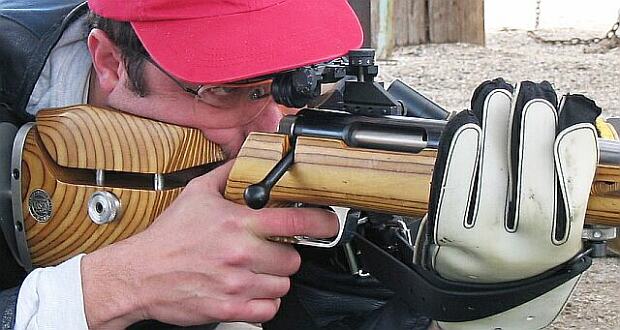
Scott Parker's Barnard-actioned 6BRX with Mastin offset prone stock.
Sling Tension
Parker: What about sling tension? I know there are many theories on this. Jerry Tierney, who shoots a .308 in Palma, and a .284 in full bore, believes solid tension is the way to go. He believes if you can easily "pop" the butt out of your shoulder the sling tension is too light.
Salazar: I use just enough sling tension to keep the rifle in my shoulder. It is, by most standards, "light". Going to more sling tension will increase pulse transmission, quicken the onset of arm numbness and overall fatigue while doing nothing positive for the stability of the hold. I use a Kurt Thune UIT II sling. It allows very fine adjustments and is flexible enough to allow me to determine the position rather than having an inflexible sling determine them for me. I cringe every time I see a sling that looks like it was stolen from the Budweiser Clydesdales tack room--and there’s plenty of those on every Highpower range (and nearly none in Smallbore, I might add).
Body Height--How Low Should You Go?
Parker: I started prone shooting with a low position. It worked well for me until I went to a Highpower clinic put on by a Marine. He put me into a high position, shortened up my length of pull and moved my hand stop closer to me. I shot well that way also. However, it seems that I have reached a plateau. This high position transmits a lateral pulse beat that is at least 1/2 minute. This can be seen on my short range targets clearly, as the groups are always twice as wide as they are tall. I will be revisiting the long and low position soon. David Kimes, former 300m world record holder, told me that the majority of World Cup shooters have their butt to hand stop length equal to twice the length of pull. This is in good agreement with your assessment.
I think it is difficult to workout all the muscle tension in the support arm in the high position. The natural tendency is for the support arm to be leveraged outboard by the sling tension. If one's natural point of aim does not allow for this, muscle exertion by the support arm will be used to correct the aim. Nine times out of ten, the shot will land out at 2:00. Do you consciously avoid using your muscles in position?
 Salazar: I agree that a very high position is really not a long-term solution. It can be helpful when trying to teach someone at the beginning phase as it ensures that the shooter is not holding the rifle with his muscles or "falling into" the rifle, but it is also very fatiguing and, as you mentioned, not the most stable way to shoot. Salazar: I agree that a very high position is really not a long-term solution. It can be helpful when trying to teach someone at the beginning phase as it ensures that the shooter is not holding the rifle with his muscles or "falling into" the rifle, but it is also very fatiguing and, as you mentioned, not the most stable way to shoot.
My position doesn't rely on muscle tension to support the rifle in any way. You asked if I consciously avoid using muscle tension. I have to say no. There isn’t a conscious effort to eliminate muscle tension because there isn’t any and if it creeps in--say from an oddly sloped firing point--it is immediately recognizable and I adjust the sling to eliminate it.
My sling is fairly low on the arm and my first checkpoint when getting into position is to push it down as far as the retaining strap on the coat allows. This ensures that it's right where I want it and that it won't creep down during a string. The next step is to push my forehand hard into the handstop to eliminate any slack between the web of the hand and the handstop. I have found that if I don't do this the first shot or two will recoil (and impact) differently. In Smallbore that's a small inconvenience but in Highpower, where you are often limited to two sighters, it can be a disaster.
 Hand and Arm Positioning--Getting "Dialed In" Hand and Arm Positioning--Getting "Dialed In"
Parker: David Tubb recommends reaching for the grip. What do you feel in the trigger hand when everything is right? And what about your arm position? I've noticed from your photos that your forearms seem to run close to the same angle--almost parallel in terms of the angle from horizontal.
Salazar: The trigger hand doesn't reach forward or have any strain at all, nor does it offer any support or steering to the rifle. If I remove the trigger hand, nothing moves. I use fairly light pressure on the grip. If you make a tube from letter paper about the diameter of your pistol grip, tape it closed and hold it just hard enough not to crush it, you have an idea of my grip pressure. I place the ammo block so that it very close to the hand and the spotting scope so that I can see through it without moving my cheek from the comb. All movement is minimized.
You asked what I feel in my arms, the answer is really nothing. I'm not conscious of my support arm and the trigger hand arm is just hanging there to operate the trigger. I have very light pressure on the pistol grip. The only position check for it is the particular spot on the finger that makes contact with the trigger needs to be exactly the same from shot to shot. The only real use of the support arm is that I'll roll the forearm of the rifle around the palm of the support arm a bit to adjust NPA if necessary. These are tiny moves and done almost without thought.
Proper Technique During Reloading and Shot Cycling
Parker: Finding and maintaining an optimum position during aiming and firing is one thing, but then you have to manipulate the rifle to load for the next shot. How does one keep good form while working the bolt and re-acquiring the target?
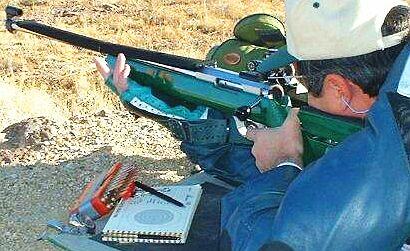 Salazar: First, as much as possible, you want to maintain your position whenever you have the rifle in your hands. And that applies during reloading/cycling as well. I've seen some shooters that move around so much it looks like they're swimming. When I get in position, I want everything (ammo, log, spotting scope etc.) to be right where I can reach it without much movement. You'll see in the photo everything is right at hand. That helps quite a bit in reducing movement--any movement leads to position breakdown. Salazar: First, as much as possible, you want to maintain your position whenever you have the rifle in your hands. And that applies during reloading/cycling as well. I've seen some shooters that move around so much it looks like they're swimming. When I get in position, I want everything (ammo, log, spotting scope etc.) to be right where I can reach it without much movement. You'll see in the photo everything is right at hand. That helps quite a bit in reducing movement--any movement leads to position breakdown.
Second, keep the rifle in the shoulder (my usual litany) while you reload. The less you move, the less you move--what else can I say about that? There's no need to keep the trigger hand elbow-glued to the mat during the reload, however. If you need to lift it, do so. Consistency pays off and re-shouldering the rifle is less consistent than leaving it in. I can write volumes on this, but I'll spare everyone the agony.
Third, arrange the spotting scope so that you don't have to lift your face off the comb to see through the scope. As much as I have worked on this over the years (since 1971), it wasn't until I got the Ray-Vin scope head recently that it became a no-brainer. This is the easiest-to-adjust scope head I've ever had. Now I can spend more of my prep time doing something other than fiddling with the spotting scope. Again, when it's properly done, you move less (and that's our goal).
Finally, the rifle has to be properly adjusted in order for the position to be comfortable, durable and repeatable. If you can lay still for 10 to 15 minutes in position (at home) while looking through the sights, you're on the right track. If you have to move and fidget to hold position, you aren't quite there yet--keep adjusting. Some adjustments are mental.
Putting It All Together--Results at the Range
 Parker: After our discussions, I decided to try some of your suggestions. I've been out twice with my 6BRX to try the longer, lower position. It works! 100-7x, 100-6x, 100-8x, 100-6x, 100-7x, 100-7x shot on the 100-yard prone target. I moved my hand stop out four inches and loosened up the sling so that it only held the rifle in the shoulder. It is so much more comfortable. It is much more forgiving of lateral errors. I have noticed that I need to release the shot in exactly the same amount of time after my respiratory pause for each and every shot. Wait a second longer, and it is a 10 at twelve. A second sooner and it is a 10 at six. Parker: After our discussions, I decided to try some of your suggestions. I've been out twice with my 6BRX to try the longer, lower position. It works! 100-7x, 100-6x, 100-8x, 100-6x, 100-7x, 100-7x shot on the 100-yard prone target. I moved my hand stop out four inches and loosened up the sling so that it only held the rifle in the shoulder. It is so much more comfortable. It is much more forgiving of lateral errors. I have noticed that I need to release the shot in exactly the same amount of time after my respiratory pause for each and every shot. Wait a second longer, and it is a 10 at twelve. A second sooner and it is a 10 at six.
Salazar: Great shooting, Scott! Now you've joined the ranks of the ground-huggers. I think you'll find a great deal more stability in your new position. Refinement over time will make it feel very natural.
My shot cycle is largely subconscious, verbalizing it might be difficult and imprecise, but I'll try. As the rifle settles from recoil on the previous shot I open the bolt and eject the case immediately, while at the same time looking through the spotting scope to see what the mirage is doing and whether it has changed since my last view before firing the shot. I reload and close the bolt and get back in the spotting scope--this takes a total of 3 to 5 seconds. Once I see the shot placement (immediate in Smallbore, sometimes delayed in Highpower) I make a decision as to windage, apply it and get ready to shoot. At this point, the shot can be broken at any time; however, I'm often waiting for a specific condition so it might be some time. If I'm waiting, I usually stay in the spotting scope as I much prefer to rely on mirage than on wind flags (when possible).
As to when the shot breaks in the cycle, I can't pin it down as closely as you did. Once I exhale, there is a window of six to ten seconds during which I’m comfortable breaking the shot. That time frame has more to with visual acuity and deterioration thereof, than with pulse beat. At some ranges with high elevation that time frame is somewhat reduced as the need to breath kicks in sooner. When looking through iron sights, I'm not aware of any movement of the front sight. When shooting scope I'm able to see that the movement is in the range of 1/4" at 100 yards and proportionately larger as distance increases. Because of the small range of movement, my attention is on a fast and smooth trigger pull; though using the word "attention" might be overstating it as these things happen without any conscious thought. I'm really just staring at my sight picture and the shot fires. It's a non-verbal state driven by the visual perception of the sight picture.
The Mental Game--The Key to Successful Shooting
 A discussion of the various physical aspects of prone shooting is always useful, but in the final analysis, the physical position is nothing more than a platform from which the real work is done. Like any platform, it can have any one of a reasonably large number of effective forms as long as it provides the requisite stability, durability and comfort. A discussion of the various physical aspects of prone shooting is always useful, but in the final analysis, the physical position is nothing more than a platform from which the real work is done. Like any platform, it can have any one of a reasonably large number of effective forms as long as it provides the requisite stability, durability and comfort.
The real keys to success in prone shooting aren't so much in the position as they are in ones mental state. I seek to be in a calm, visual, non-verbal, aware, and responsive state. Decisions have to be made constantly and quickly without hesitation or over-analysis. Verbal processes slow everything down and should be avoided. While self-talk is useful before going on the line, it can be a hindrance during shooting, other than an occasional simple "key-word" reminder such as "shut up!" when some self-chatter starts to creep in. A more useful key-word that I sometimes use is "center" and that really keys in the sight picture.
Most of this article has been about physical factors (body positioning and bio-mechanics), but there is a psychological side which deserves equal consideration. I think that releasing tension throughout the body (avoidable tension) is even more a mental process than a physical one. Once all of the adjustments are properly set, you could have a position free of avoidable tension for the rest of your life. But that rarely happens. The reason is simply that we allow mental stress to appear as physical stress and tension. Relieving mental stress is a huge topic unto itself, but a few points to remember on the line are to be looking for stress, to be conscious of it, to breathe, relax and feel every part of your body.
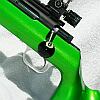 I find that prone shooting is a very tactile exercise. When I'm in position I seem to develop a heightened sense of touch, not just in my fingertips, but throughout my body. I feel cheek and shoulder pressure variations of very small magnitude. I feel the ground through the mat. I feel the tiniest bit of wind on my skin. Think about that and when you are next in position try to sense and feel everything, and relax each area of the body as you feel it. It can be done; I realize this can sound a bit like mumbo-jumbo, but it's real. —German Salazar— I find that prone shooting is a very tactile exercise. When I'm in position I seem to develop a heightened sense of touch, not just in my fingertips, but throughout my body. I feel cheek and shoulder pressure variations of very small magnitude. I feel the ground through the mat. I feel the tiniest bit of wind on my skin. Think about that and when you are next in position try to sense and feel everything, and relax each area of the body as you feel it. It can be done; I realize this can sound a bit like mumbo-jumbo, but it's real. —German Salazar— |

| Salazar's Stable of RPA Quadlite Prone Rifles | 6mm BR Blue Rifle (top)
Action - RPA Quadlite, LB/LP
Caliber - 6BR
Stock - Master Class Highpower Prone
Metal Work - Alan Warner
Stock Work - Alex Sitman
Painter - Gary Cole, Miami
Barrel - Krieger, 6mm, 1:8" twist, 30"
Sights - Warner rear sight, Scott Riles front sight. Gehmann apertures on both.
Trigger - Jewell 4 oz. | 22 PPC Green Rifle
Action - RPA Quadlite, LB/LP
Caliber - .22 PPC
Stock - Master Class Highpower Prone
Metal Work - Alan Warner
Stock Work - Alex Sitman
Painter - Gary Cole, Miami
Barrel - Broughton, .224", 1:8" twist, 30"
Sights - Warner rear sight, Scott Riles front sight. Gehmann apertures on both.
Trigger - Jewell 4 oz. | 6mm BR Flame Rifle
Action - RPA Quadlite, LB/LP
Caliber - 6BR
Stock - Master Class Highpower Prone
Metal Work - Alan Warner
Stock Work - Alex Sitman
Painter - Gary Cole, Miami
Barrel - Broughton, 6mm, 1:8" twist, 30"
Sights - Warner rear sight, Scott Riles front sight. Gehmann apertures on both.
Trigger - Jewell 4 oz. |
Prone Stocks--Proper Set-up and Adjustment
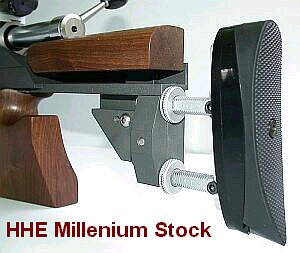 Adjusting Prone Stocks Adjusting Prone Stocks
German Salazar told us that many novice shooters struggle with their prone positions because they really don't know how to set up their stocks properly. Unless you have the cheek-piece, handstop, and butt-plate adjusted correctly you'll be fighting your gun, rather than using that expensive stock to its best advantage.
Likewise, the rear sight must be positioned correctly for proper eye relief when you are in your natural firing position. And once you get the stock/sights set up correctly, you want to record all the settings.
Here are German's tips for setting up a modern, adjustable prone stock:
1. Get into the prone position with your rifle without a sling, handstop or rear sight attached.
2. Adjust the length of pull (LOP) so that your cheek falls on the front part of the cheek-piece without being forward of it.
3. Bring the handstop in to where your hand is resting on the fore-end, it should be a comfortable, natural spot. Work with the sling to get proper tension and then readjust the handstop and LOP as necessary to maintain that forward head position and a comfortable hand position. You may need to do a lot of fine tuning and fiddling here.
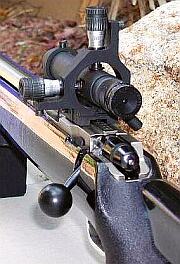 4. Raise the butt-plate about 1" to 1.5" over center. 4. Raise the butt-plate about 1" to 1.5" over center.
5. When the rifle feels comfortable, close your eyes, then have someone mount the rear sight so that the aperture is about 1" from your eyebrow. This has to be done with eyes closed or you'll tend to crawl towards it while your helper installs it.
6. Raise the cheekpiece until you can't see through the sight. Lower it slowly until the front sight comes into view and is centered. Then stop! Always adjust by coming down from above. That will keep you from lifting your head to compensate.
7. If your stock has a lateral offset adjustment in the butt-plate, move it out at least 1/2" initially and continue to work with it until you are able to bring the rear sight into true alignment with your aiming eye.
8. Revisit the sling adjustment. Loosen and tighten a couple of notches from where you are. Bear in mind that a tight sling that may feel fine for a few minutes can be a real hinderance over a 25-minute string of fire.
9. Keep working at it! Stock adjustments can and will need small changes over time, some permanent, some temporary to adjust to range conditions. The key to the process is developing a finely-tuned sense of what your position feels like when you are shooting well and tuning the stock adjustments to replicate that feeling at any range.
Record-Keeping--the Key to Repeatability
Measure and record the LOP, the distance from the butt-plate to the front of the handstop, and the distance from the butt-plate to the rear aperture. Mark and record the holes used in the sight and the sight base, mark the forend for the handstop, mark the sling hole used.
Highpower competitors shooting in three positions will also need to make adjustments for standing and sitting. For sitting, lower the butt-plate to a neutral (centered) position and repeat the above drill. Record everything. You'll probably end up with LOP similar, sight further forward, handstop pulled back, sling shorter. For standing, drop the butt-plate as far as it will go, leave the handstop in the sitting position (less work when you shoot sitting right after standing), LOP the same or a bit shorter, move the sight back toward the eye. It's a fair amount of work to set up, but you can record everything and make quick adjustments at the range between positions. A measuring tape, masking tape (to write on the rifle) a notebook, and a Sharpie are essential tools! |
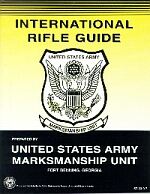 Resources for Prone Shooting Resources for Prone Shooting
From the Civilian Marksmanship Program (CMP):
Service Rifle Marksmanship Guide and International Rifle Guide
The USAMU Guides were written and illustrated by the shooters and coaches of the U.S. Army Marksmanship Unit Rifle Teams. The CMP issues these Guides to promote marksmanship and training competition. The International Rifle Guide, NLU #777, is best for intermediates, while the Service Rifle Guide, NLU #780, suits all shooters. Definitely get one or both of the USAMU Guides. $3.95 each.
From Champion Shooters Supply:
Ways of the Rifle by Gaby Buhlmann, Heinz Reinkemeier and Maik Eckhardt
Translated from German by Bill Murray. Just released this year, the 208-page large-format soft cover treatise covers all positions and features many of the world's top rifle shooters. Many high-quality illustrations. German highly recommends this book to all prone competitors. $44.50
New Position Rifle Shooting by Frank Hanankrat and Bill Pullum
The New Position Rifle Shooting book is an all-new, comprehensive guide to championship target shooting, based on the classic Position Rifle Shooting book. The new volume is an authoritative guide to the latest technical and physiological teachings on advanced marksmanship. $17.95
High Power Rifle by David Tubb
Written by the undisputed "King of Camp Perry", the 11-time National High Power Champion, G. David Tubb. David offers offers insights and advice on equipment, shooting in wind, shooting technique, and, most importantly, developing and applying a winning strategy. $14.95
Did You Enjoy This Article? Please Consider Making a Small Donation:
Copyright © 2005 AccurateShooter.com and 6mmBR.com, All Rights Reserved. No reproduction of any content without advanced permission in writing.
Topics: Palma, Prone, High Power, Highpower, Smallbore, Small bore, sling, iron sights, 300m, 300 meter, RPA, Quadlite, Mastin, Barnard, MT Guns, Scott Riles, Master Class Stocks, MasterClass, Warner Tool, Broughton, Krieger, Anschutz, HHE, Millenium, Rifleman, Marksmanship, CMP, Camp Perry, NRA,Silhouette, single-shot, switch-barrel, shooting, rifle accuracy, 6BRX, 6 BRX, 22 PPC, .223 Remington, 6BR, 6mm BR, 6mm Norma, 6PPC, 22PPC, 220 Russian, 6mmBR, 6BR, 6 Dasher, .308 Winchester, reloading, powder selection, case forming, fire-forming, Lapua Brass and Hornady bullets.


|